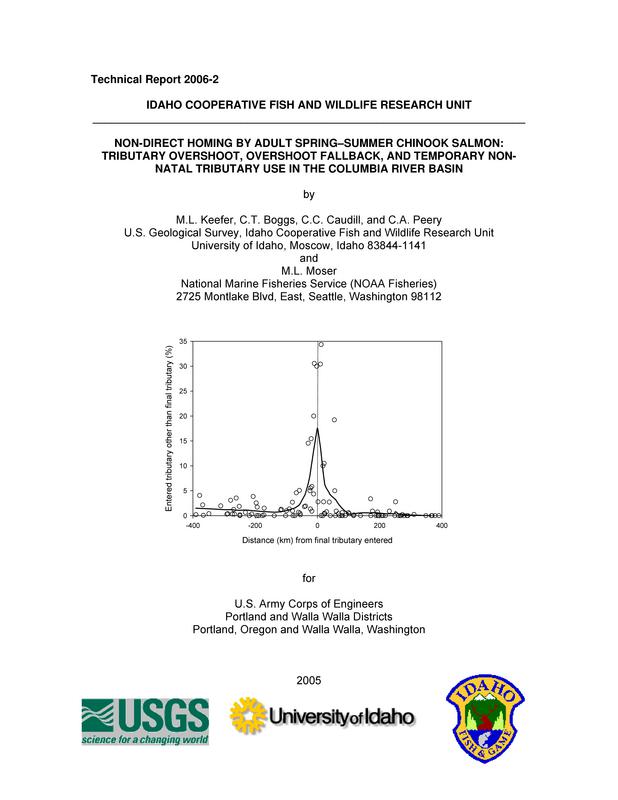PDF
Non-Direct Homing By Adult Spring–Summer Chinook Salmon: Tributary Overshoot, Overshoot Fallback, And Temporary Nonnatal Tributary Use In The Columbia River Basin Item Info
- Title:
- Non-Direct Homing By Adult Spring–Summer Chinook Salmon: Tributary Overshoot, Overshoot Fallback, And Temporary Nonnatal Tributary Use In The Columbia River Basin
- Report Type:
- Technical Report
- Date:
- 2005
- Authors:
- Keefer, M.L.; Boggs, C.T.; Caudill, C.C.; Peery, C.A.; Moser, M.L.
- Affiliations:
- Fish and Wildlife Sciences, University of Idaho; National Marine Fisheries Service, National Oceanic and Atmospheric Administration
- Report Number:
- 2006-2
- Publisher:
- University of Idaho
- Funder:
- U.S. Army Corps of Engineers, Portland District; U.S. Army Corps of Engineers, Walla Walla District
- Abstract:
- Homing movements of adult salmon and steelhead in the Columbia River system is a poorly understood aspect of migration, yet has important ecological and management implications. In this study, three migration behaviors—overshoot of natal tributaries, fallback at dams upstream from natal tributaries, and temporary non-natal tributary use—were evaluated for more than 5200 radio-tagged spring–summer Chinook salmon Oncorhynchus tshawytscha. Over seven years, from 1% to almost 80% of eleven Columbia River study stocks initially overshot natal tributaries and were recorded at upstream Columbia or Snake River dams (mean = 29%). Smaller proportions of each stock were recorded falling back at upstream dams (range = 0–49%, mean = 17%). The contribution of overshoot fallback to total fallback by salmon that returned to tributaries was approximately 20% at The Dalles, John Day, and Ice Harbor dams and was about 40% at McNary Dam. Proportions that temporarily entered non-natal tributaries ranged from 8% to 42% (mean = 22%) of each stock. Overshoot, overshoot fallback, and temporary tributary use behaviors were greatest when spawning tributaries and/or dams were in close geographic proximity. For example, 39% of Klickitat River salmon fell back at The Dalles Dam, 49% of Umatilla River salmon fell back at McNary Dam, and salmon from Bonneville pool tributaries were most likely to temporarily use nearby tributaries. In multivariate models, hatchery origin, fish sex, migration timing, and fallback at both upstream and downstream dams were also associated with non-direct homing behaviors. Overshoot and temporary tributary use events were complex and inter- related, likely reflecting a combination of active searching for olfactory cues from natal tributaries, behavioral thermoregulation, and geographic proximity among sites.
- Species:
- Chinook salmon, Oncorhynchus tshawytscha
- Location:
- Bonneville Dam; Columbia River; Snake River; Lower Granite Dam; The Dalles Dam; John Day Dam; McNary Dam; Ice Harbor Dam; Lower Monumental Dam; Little Goose Dam
- Subjects:
- salmonids Federal Columbia River Power System FCPRS radiotelemetry migration homing behaviors
- Source:
- University of Idaho, Fish Ecology Research Lab
- Original Filename:
- 2006-02-CK-overshoot-Columbia-basin-1996-2003.pdf
- Format:
- application/pdf
Source
- Preferred Citation:
- "Non-Direct Homing By Adult Spring–Summer Chinook Salmon: Tributary Overshoot, Overshoot Fallback, And Temporary Nonnatal Tributary Use In The Columbia River Basin", Adult Salmon and Steelhead Migration Studies: 1996-2014, University of Idaho Library Digital Collections, https://www.lib.uidaho.edu/digital/ferl/items/ferl-tr-2006-2.html
Rights
- Rights:
- These files are provided for research purposes with copyright held by the original authors. Please contact the publishing organization for more information about rights.
- Standardized Rights:
- http://rightsstatements.org/vocab/InC-EDU/1.0/

